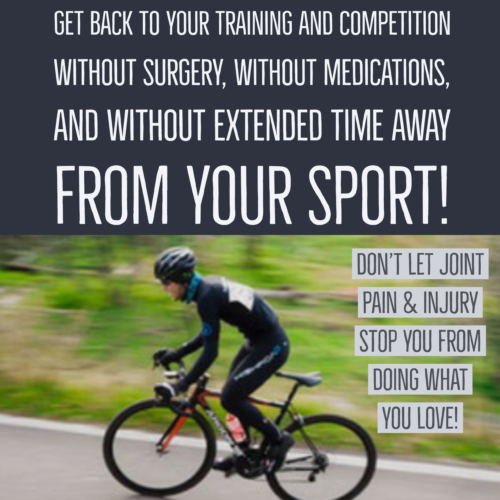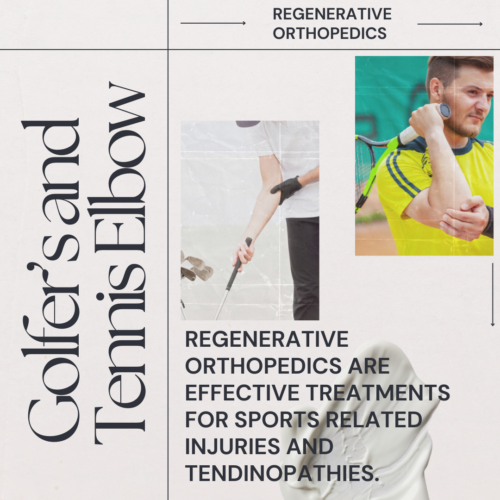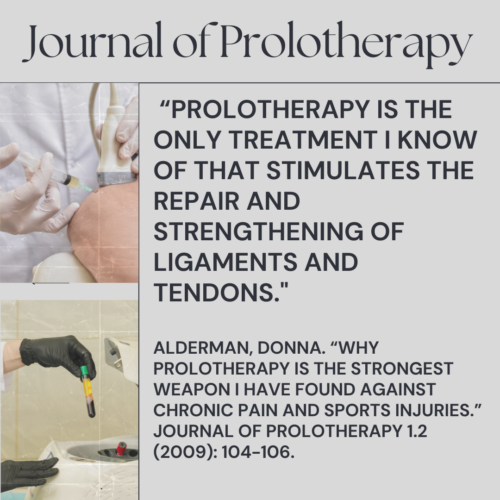We see athletes of all ages in our clinic all of the time. It doesn’t matter if you are 15 or 95. Because if you love sports or enjoy an active lifestyle, you don’t want to have to stop because of an injury. And Regenerative Orthopedics is the ideal sports medicine to get you back in the game!
Sports injuries from ligament tears, meniscus injuries, tendon injuries, wear and tear, and other soft tissue injuries are common reasons people seek care. In fact, over 90% of athletic injuries involve stretched, torn or weakened soft tissue of some sort. Sports injuries, whether of the ankle, knee, shoulder, hip, or back occur when the repetitive strain of the athletic activity is too much for a particular ligament, tendon, or muscle to perform.

Keep Doing What You Love
Injury to these soft tissue structures can transpire from a sudden traumatic injury or as a result of accumulative damage over the years. Many are considered an acute exacerbation of a chronic injury. Whether you run 3, 6, 10 miles or even a marathon, ride your bike, participate in martial arts, lift weights, play golf or tennis, the repetitive impact from athletic events can be enough to damage the various soft tissue structures.
Over time the joint degenerates as these non-healed soft tissue injuries destabilize the joint. And Regenerative Orthopedics is an ideal sports medicine because it is extremely effective at healing and repairing these soft tissue injuries.
Golfer’s Elbow, or medial epicondylitis (ME) and Tennis Elbow, or lateral epicondylitis (LE), are common sports-related conditions that are effectively treated with Regenerative Orthopedics. Golfer’s Elbow is due to excessive force encountered during the golf swing. In the working population, the condition is frequently seen in manual laborers who require frequent wrist flexion and pronation along with grasping. Medial Epicondylitis is frequently accompanied by other pathology in the soft tissue of the elbow. and treatment is directed towards addressing the tendon and ligament degeneration. Fortunately, Regenerative Orthopedics is a comprehensive treatment directed at the repair of the soft tissue in the entire elbow area, with the capabilities of treating all affected areas.
Tennis elbow (lateral epicondylitis) is a frequent cause of elbow pain and is reportedly the most common disorder of the arm causing disability. The condition may resolve on its on. But when the disorder persists, regenerative treatment can effectively resolve and repair it.
PRP, an autologous (from your own blood) product of concentrated platelet-derived growth factors can ideally enhance healing. “In comparison to steroid injections, PRP has shown to be more efficacious in the long term improvement of symptoms in lateral epicondylitis. (1)

Prolotherapy is also a very effective treatment and shows promising results in chronic tendinopathies. (2) Prolotherapy can be used alone, or in more severe cases, may be recommended along with PRP. Prolotherapy is an effective treatment method in the lateral epicondylitis of elbow. (3) Prolotherapy is a minimally invasive, safe therapy that stimulates the body to heal painful areas. It has a high success rate and strengthens tissue rather than weakening it. (4)
Doesn’t the body just heal on its own? Unfortunately, not all of these structures heal well on their own. Soft tissue structures like the cartilage, discs, labrum, ligaments, menisci and tendons are whiter in nature. That means they have a poor blood supply.
“Think of a sprained ankle. A sprain is an overstretching, twisting and/or tearing of a ligament, the tissue that holds bones together. When a sprain occurs, the body’s “healing program” kicks in and the stimulus to heal begins. At first, this stimulus to heal is strong but over the ensuing weeks diminishes and then eventually stops. Unfortunately soft tissue, specifically joint ligaments and tendons, often do not heal completely after an injury because of limited blood flow to these areas. Therefore if healing is not 100% (and often isn’t), the person is left with a remnant of that injury. This remnant makes the joint a little weaker and more prone to another injury.” (4)
Blood is what nourishes the joint. And therefore, the blood poor structures have a compromised healing ability after injury. These structures aren’t like muscles. You’ve probably noticed when you pull a muscle, or sustain a muscle injury, that in time, it will get better. Why is that? The muscles are red. That means they have a good blood supply and repair more easily. Regenerative Orthopedics helps the body to get more blood to these blood poor structures so they can heal more efficiently. Dr. Donna Alderman says this, “Prolotherapy (and other Regenerative Orthopedics) is the only treatment I know of that stimulates the repair and strengthening of ligaments and tendons. You could say, then, that Prolotherapy is “body- building” for the ligaments and tendons.” (4)

In order for the joint to function like it should, all of the joint structures, including the white tissue structures, the muscles and the bony structures need to be well. They all work together to stabilize the joint and keep it working optimally. But the ligaments are the primary stabilizing structures.
Ligaments are key at maintaining joint health. Unfortunately, ligament injuries are one of the most common causes of pain from sport-related injuries. And they are white tissue structures. Plus, injured ligaments generate pain. They are a sensory organ with free nerve endings. The weakness that occurs after ligament injury to the knee, for example, may give rise to Runner’s knee, meniscal tears, chondromalacia patella, bone spurs and eventually to arthritis.
When the ligament is injured, the harmony between the soft tissue, muscles and bony structures is disrupted. This interferes with mobility and joint stability. What results is an unstable joint, one that moves abnormally, and functions poorly. That results in more and more damage. When the ligaments are left untreated, the body will try to stabilize the joint by causing ongoing muscle spasms, and joint swelling. And eventually, bone spurs will form and arthritis will develop. A cycle of persistent pain is the result.
Involvement in athletics provides us with physical, emotional and mental well-being. However, when we’re faced with injury, we often set into motion the cycle of instability in the joint as mentioned above. This cycle also leads to the eventual development of arthritis. The path to arthritis can occur within a few years with severe injuries, or take decades to develop when the injury is less severe.
Although progressive cartilage loss with its inhibition of joint motion plays a central role in arthritis, injury to other soft tissue structures actually initiates the change in equilibrium that leads to this breakdown of cartilage and the path to arthritis. Athletes of all ages desire to be as fit as when in the prime of their athletic careers. But the pain and symptoms from non-healed sports injuries interferes with that dream!
Regenerative Orthopedics is the ideal sports medicine because in gets the athlete back on the path of healing and to reaching their goals and dreams.
Standard treatments for sports injuries usually only involve the management of symptoms. Some of these treatments include pain medications, cortisone/steroid injections, physical therapy, massage and other therapies to provide pain relief. These treatments may work to relieve pain temporarily or momentarily reduce the pain and inflammation.
But when the athlete turns off the pain signal with medication use, while the joint is still injured, and continues to play and remain active on an injured joint, further damage ensues. It is important to realize that these treatment modalities do not repair soft tissue injuries, such as tendon, ligament, and meniscus tears, nor do they regenerate cartilage.
The key to keeping joints strong is to stimulate the area to heal. Regenerative Orthopedics does just that. And it offers hope to those suffering from sports injuries. They are the ideal treatment for sports injuries because they get you back to doing what you love.
Plus, these therapies are non-surgical. The treatments regenerate and repair the damaged ligaments and soft tissues. And they allow the athlete to continue with their desired activity. Non-surgical regenerative therapies, including Stem Cell Therapy, PRP, and Prolotherapy, stimulate the natural regenerative processes in and around the joint. And they facilitate the restoration of the degenerated soft tissue to a healthy state. The result is improved joint support and function, and reduced pain and symptoms.
Regenerative Orthopedics involves the injection of natural solutions. And sometimes, depending on the nature of injury or degeneration, will also include injections of an autologous preparation, from a person’s own plasma (blood), fat or bone marrow, injected directly into the damaged joint to accelerate the healing process.
Regenerative Orthopedics is a great non-surgical treatment ideal for offering not only pain relief from sports injuries, but healing and reparation at the source of the injury. This regeneration and repair enables the athlete of all ages to speedily return to the sport or activity they love with minimal lifestyle interruption.
(1) Peerbooms JC, Sluimer J, Bruijn DJ, Gosens T (2010) Positive effect of an autologous platelet concentrate in lateral epicondylitis in a double- blind randomized controlled trial: platelet-rich plasma versus corticosteroid injection with a 1-year follow-up. Am J Sports Med 38: 255-262.
(2) Distel LM, Best TM (2011) Prolotherapy: a clinical review of its role in treating chronic musculoskeletal pain. PM R 3: S78-81.
(3) Shin, Ju Yon, et al. “The effect of prolotherapy on lateral epicondylitis of elbow.” Journal of the Korean Academy of Rehabilitation Medicine 26.6 (2002): 764-768.
(4) Alderman, Donna. “Why Prolotherapy is the Strongest Weapon I have found against Chronic Pain and Sports Injuries.” Journal of Prolotherapy 1.2 (2009): 104-106.